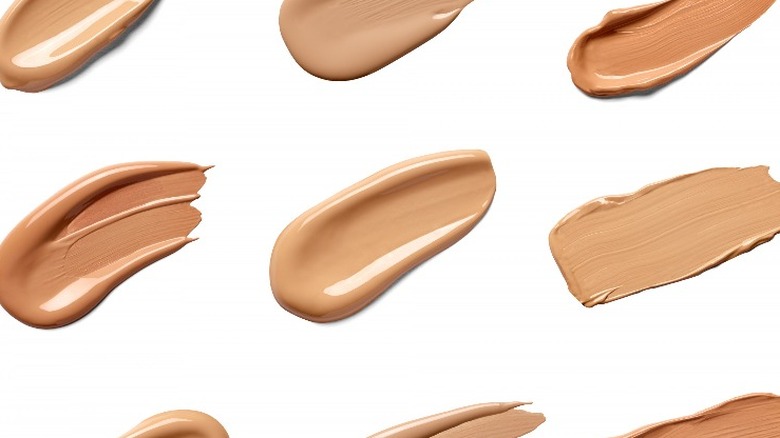Here's What Your Foundation Is Really Made Out Of
Of all the makeup products out there, perhaps none have a more intimate relationship with our faces than our foundation. As such, we expect a lot from it. With so many options on the market, it is easy to get lost in the selection. And on the quest to find the perfect shade, many consumers forget one thing: what is actually in foundation? Naturally, the answer depends on the kind of foundation you're looking for.
Keep in mind that, in addition to green-flag ingredients, there are also plenty of red-flag ingredients in foundation to be aware of, for example, certain parabens and phthalates, per Byrdie. Research on parabens in cosmetics and body products suggests that parabens can disrupt hormones, harm reproductive organs, and even increase the risk of cancer, per EWG. Research has also suggested that phthalates could have similar affects, per Medical News Today. The FDA does not have to approve ingredients for cosmetic use.
While "clean beauty" makeup products might generally incorporate safe synthetic ingredients, this does not mean they are free of chemicals completely, per The Washington Post. So, what exactly is in your foundation?
Know your bases
The first step to any foundation is its base. There are three main kinds of liquid foundation bases: water, silicone, and oil, per Makeup.com. Foundation can also be powder-based, per Byrdie. Each comes with different properties and effects on the skin, so it is important to also understand your specific skin type to find your best foundation match, formula-wise. Foundations may also include a number of other ingredients that can be categorized as emulsifiers, pigments, emollients, and more, which each play a specific role in the overall effect of the foundation. For example, emulsifiers maintain the overall consistency of the formula, while emollients maintain the skin's moisture, per Beautylish.
Water-based foundations are known for being gentle on the skin, per Makeup.com. Often moisturizing and nourishing, water-based foundations can work well for those who have drier skin or breakouts, and those who seek a more natural finish to their makeup look. Now, it is important to note that water-based means just that, while the foundation's main binding agent will be water, it could still also contain other ingredients that would be categorized as oils or silicones.
Silicone creates a soft texture
So how do you spot a silicone-based foundation? Check for ingredients that end in -cone, -methicone, -silicate, or -siloxane. Should you find these ingredients toward the top of your foundation's ingredient list, chances are, you have a silicone-based foundation, per HealthyGlowyMe. Silicones are a synthetic polymer technically created from a natural mineral, silica, but have been chemically processed, per HeroCosmetics. Silicone is used in foundation because it creates a soft texture over the skin, maintains the skin's moisture–though it does not moisturize on its own–and upholds a barrier between your skin and the rest of the world. Neat, right?
Another benefit to silicone-based foundation is that it is non-comedogenic and hypoallergenic, which is fantastic for those with sensitive skin. Just be warned that, because of silicone's propensity to keep things intact, it is not ideal for acne-prone skin that needs nourishment to heal. Instead, you should look for foundations for acne-prone skin.
Oil-based foundations are ideal for dry skin
Oil-based foundation is often thicker than water-based and silicone-based foundations and typically features a kind of oil, such as mineral oil or paraffin oil, as one of its first ingredients, per The Foundation Fairy. This kind of foundation can work wonders for those with drier skin, as it both moisturizes and illuminates the face.
When it comes to applying your foundation, there is another oft-forgotten step to consider if you use a primer: is the base of your primer compatible with the base of your foundation? For example, a water-based primer with a water-based foundation will congeal together beautifully. But a silicone-based primer and a water-based foundation? Those will simply slip and slide all over your face, notes Makeup.com. If you can't quite figure out why your foundation isn't sitting properly, this could be why. While the way you use your primer will depend on your skin type, per Allure, here are a few of the best hydrating primers for dry skin, should you be looking for inspiration.



